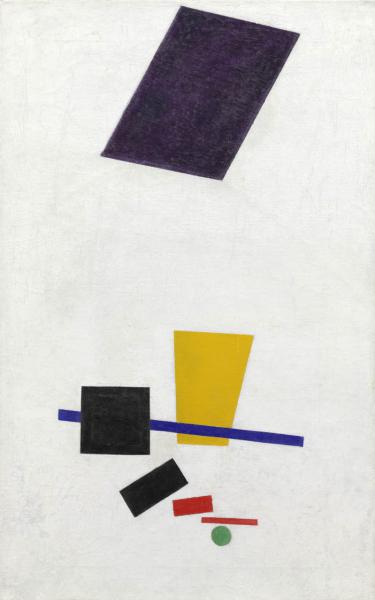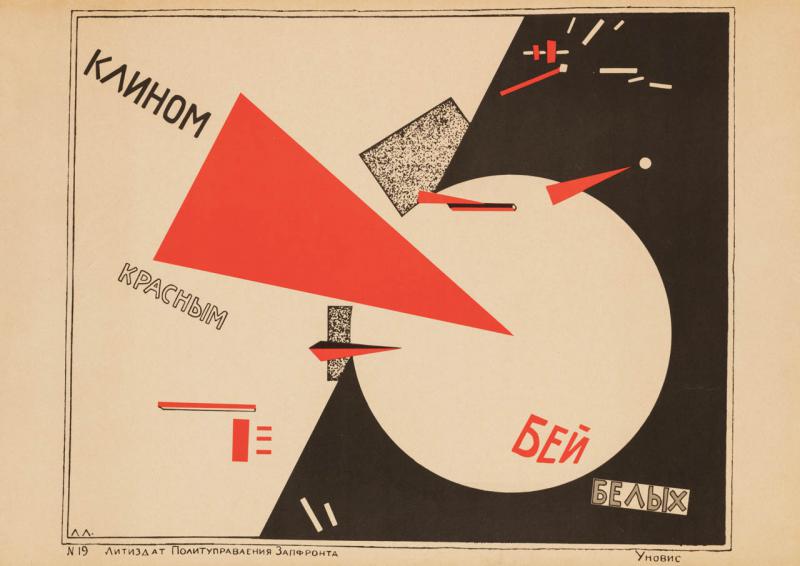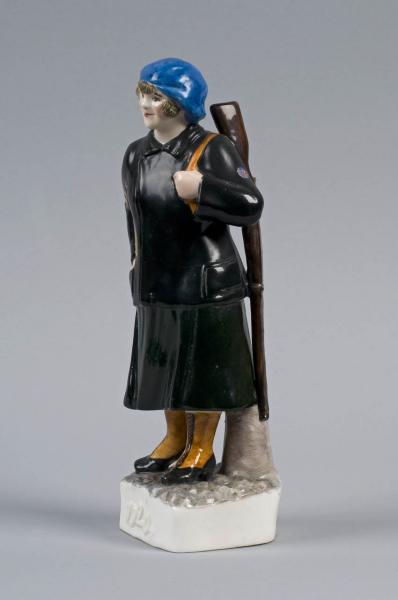Events at the Art Institute during the ASEEES 2017 Convention
By Kathleen Tahk, The Art Institute of Chicago
This article was originally published in the October 2017 edition of NewsNet.
Opening at the Art Institute of Chicago on October 28, close to the centenary of the Bolshevik Revolution, Revoliutsiia! Demonstratsiia! Soviet Art Put to the Test presents the largest exhibition of early Soviet art to be held in the US in 25 years. Over 500 original works – including paintings, photographs, works on paper, printed matter, sculpture, decorative arts, architectural models, and ephemera – cover the gamut of cultural production from the period between 1917 and 1937. This wide-ranging survey draws from multiple major international collections – notably the Ne boltai! Collection and the Costakis Collection at the Greek State Museum of Contemporary Art – as well as several important private lenders. This roundtable is also featured on ASEEES's website as a special event during the convention.
In conjunction with the exhibition, two ASEEES convention roundtables will take place at the museum on Thursday, November 9 from 3:30 to 7:30 pm. For the first roundtable, “Objectivities: Engaging with the Materiality of Art,” works of Russian and Soviet art will be installed for discussion and close examination in the Ryerson and Burnham Libraries. Following this, curator Matt Witkovsky will lead a special walking roundtable inside the exhibition with catalogue contributors Masha Chlenova, Christina Kiaer, Kristin Romberg, and Kathleen Tahk. The Art Institute will offer free admission to all convention attendees from November 9–14 so that they can further explore the exhibition.
The Art Institute has also scheduled several public programs during the convention. On Saturday, November 11 at 11:00 am playwright Tony Kushner and author Jeremy McCarter will discuss the latter’s recent book Young Radicals: In the War for American Ideals. Also on November 11, Mark Steinberg will present his lecture “The Russian Revolution as Utopian Leap” in the museum’s Fullerton Hall at 3:00 pm. The Chicago Symphony Orchestra’s Oberon Ensemble will perform Shostakovich’s Piano Quintet in G minor, Op. 57 on Sunday, November 12 at 2:00 pm, also in Fullerton Hall. Further details on these events can be found on the Art Institute’s website: www.artic.edu.
The exhibition itself deliberately eschews a simple chronological arrangement of works, organizing them instead into nine thematic spaces of display: Battleground, School, Theater, Press, Factory, Exhibition, Festival, Storefront, and Home. Choosing to arrange the works spatially resists the common teleological narrative, which draws a seemingly inevitable path from the avant-garde to socialist realism, from revolution to Stalinist terror.
Entering the exhibition, visitors first encounter the Battleground. A selection of Civil War-era posters – ranging from El Lissitzky’s abstract masterpiece Beat the Whites with the Red Wedge, to the anti-Bolshevik satire A Happy Worker in Sovdepiia, to hastily-produced cartoons by unknown regional artists – mirrors the partisan violence of these early years. This opening section introduces viewers to the beginnings of the vast propaganda campaign that would continue throughout the first two decades of Soviet power. Battleground here is not limited to the Civil War front, but encompasses all of Soviet society, where everyday life, too, was a front in which the battle to achieve the promises of the revolution.
After passing through Battleground, visitors are free to move through the other spaces in any order they choose. Spaces, moreover, intersect at different points in the exhibition hall, encouraging visitors to consider the connections between, for example, Festival and Press, Storefront and Home. Interspersed with the historical art works in each section are newly commissioned reconstructions of several large-scale projects: Aleksandr Rodchenko’s Workers’ Club (1925), Gustav Klutsis’s agit-prop tribune (1922), El Lissitzky’s display space Room for Constructive Art (1926), Varvara Stepanova’s set pieces for The Death of Tarelkin (1922), the Constructivist sculptures from the second Obmokhu exhibition (1921), and several modular furniture pieces designed by students at VKhUTEMAS (1923–1928). Artists’ notes and drawings, historical photographs, and current research guided the expert construction of these replicas. Replication and reproduction, arguably, are the very basis of Soviet aesthetics, which deeply opposed the bourgeois fetishization of the original. Two-dimensional works circulated as reproductions in magazines and on postcards, and architectural and design models, often planned for mass production, appeared in exhibitions. Rodchenko, for example, designed his workers’ club as a prototype for display in the 1925 Paris Exposition of Modern Decorative and Industrial Arts, and a 1926 issue of the magazine Sovremennaia arkhitektura illustrated his maquette and design sketches, not the built structure.
 The reconstructions also highlight a key theme in the exhibition: models. Each exhibition space represents a sphere of activity where Soviet artists presented exemplary works that demonstrated how society could be reshaped into a classless, democratic collective. Artists’ debates and discussions consistently stressed the need for experimentation, criticism (especially self-criticism), and revision on the path to a truly socialist art. In a sense, therefore every work was a test model to be evaluated and improved upon in practice.
The reconstructions also highlight a key theme in the exhibition: models. Each exhibition space represents a sphere of activity where Soviet artists presented exemplary works that demonstrated how society could be reshaped into a classless, democratic collective. Artists’ debates and discussions consistently stressed the need for experimentation, criticism (especially self-criticism), and revision on the path to a truly socialist art. In a sense, therefore every work was a test model to be evaluated and improved upon in practice.
Visitors can experience the constant demonstration and testing of ideals across all nine sections. In School, abstract Suprematist and Constructivist art works by Kazimir Malevich, Aleksandr Rodchenko, and other key members of the avant-garde who joined the post-revolutionary art school professoriate show their pursuit of basic principles in art. On view here is a series of paired drawings, produced in a critical 1921 discussion at the experimental artistic research institute INKhUK, illustrates the participating artists divergent interpretations the distinction between a composition and a construction. Nearby, projects for inkwells, textile patterns, furniture, kiosks, and other everyday objects by these artists and their students show the attempts to organize the world outside the art school walls according to the principles developed inside them. Prominent in Theater are innovative designs by Liubov’ Popova and Varvara Stepanova for stage productions and mass actions under Vsevolod Meyerhold, which redefined the conventions of dramatic performance and elided actor and audience. Mass demonstrations and sports parades, key components in the celebration of revolutionary holidays, also worked to turn passive spectators into active participants through total participation. In Festival sections, photographs of these occasions by the first generation of Soviet photojournalists – Arkadii Shaikhet, Maks Penson, Georgii Zel’ma, Boris Ignatovich, and others – depict the nascent collective on display. Works in Festival encompass celebratory monuments both the ephemeral – for example, Gustav Klutsis’s designs for monumental but temporary photomontage installations – and the (would-be) eternal – an original wooden model of Boris Iofan’s project for the Palace of the Soviets.
One of the richest areas of the exhibition is Press, which presents a wide selection of period books, journals, and magazines. The power of mass media to address the masses in their millions inspired heated debates over the proper role of typographic design and photographs and illustrations in a “true” socialist press. Issues of the journals Rost, Daesh’!, Krasnaia niva, Novyi lef, Krasnaia panorama, Ogonek, and others show the different answers offered by competing artistic groups, particularly during the transformative years of the First Five-Year Plan. Like Press and Festival, Exhibition also explores highly public displays of Soviet cultural production, in this case on the world stage. Alongside the replica Room for Constructive Art – installed here with contemporary works by the same artists selected for the original 1926 Dresden installation – visitors can see drawings, photomontages, and catalogues from El Lissitzky’s international exhibition design, including the Soviet pavilions at Pressa (1928) and the International Hygiene Exhibition (1930).
Visitors enter the Home space, a separate room in the exhibition, after passing through Storefront. Consumer goods, ranging from luxury porcelain to reproduction printed cotton fabrics, appear in both sections, first in mock storefront windows and then on the reproduction Constructivist furniture. Home is especially suited to the exhibition’s non-chronological arrangement. The accumulation of objects old and new, personal and mass-produced, which defines the domestic interior, posed a particular challenge in the transition to socialism. Also on display in Home are personal photographs, watercolors, and albums, as well as hand-drawn “orders” from a young Svetlana Allilueva to her father Joseph Stalin that chillingly merge the personal and the political.
A space inside the exhibition hall – modeled to the scale of early agit-train cars used as impromptu cinemas – will screen three programs of films. The first program, which will run during the ASEEES convention (October 28 – November 21, 2017), features Lenin Kino-Pravda (1925) and The Storming of the Winter Palace (1920), as well as rarely screened works: the comedic stop-motion trailer The Event at the Stadium (1929), the public safety film How to Walk in the Street (1925), documentary footage inside Goskino studios (1924), and the animated short The Skating Rink (1927). ASEEES members in the Chicago area will want to return for the subsequent two programs, scheduled for November 22 – December 17, 2017 and December 18, 2017 – January 14, 2018 respectively, which will include Ten Minutes in the Morning (1931), Youth in Bloom (1938), The Microbe of Communism (1925), China in Flames (1925), and others short films. The complete list of films for all three programs will be posted outside the cinema space.
Kathleen Tahk is the Rice Postdoctorate Curatorial Fellow in Photography at the Art Institute of Chicago
